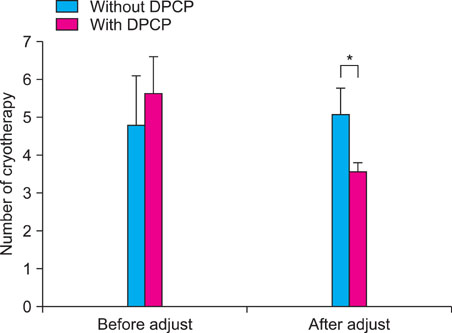Ann Dermatol.
2011 Aug;23(3):282-287. 10.5021/ad.2011.23.3.282.
Does Immunotherapy of Viral Warts Provide Beneficial Effects When It Is Combined with Conventional Therapy?
- Affiliations
-
- 1Department of Dermatology, Seoul National University Boramae Hospital, Seoul, Korea. bell711@hanmail.net
- KMID: 2171917
- DOI: http://doi.org/10.5021/ad.2011.23.3.282
Abstract
- BACKGROUND
Cryotherapy has been accepted as the mainstay in treating periunugal and palmoplantar warts. The major drawback of cryotherapy is the requirement of several unbearably painful treatment sessions.
OBJECTIVE
This study aims to assess the efficacy of immunotherapy in viral wart treatment, as an adjunctive method to cryotherapy.
METHODS
Retrospective chart review was performed on 124 patients visiting the hospital from January to December 2009 for the treatment of periungual and plantar warts. We analyzed the number of cryotherapy sessions necessary for treating warts and assessed the clinical benefits from the addition of other treatment modalities, by adjusting the various confounding factors.
RESULTS
Of the 124 investigated patients, immunotherapy with diphenylcyclopropenone (DPCP) was performed in 14 patients (11%), together with cryotherapy. After adjusting the factors related to the therapeutic difficulties of wart, the average number of cryotherapy sessions for the immunotherapy-combined group was significantly lower (3.58+/-1.25) than that for the cryotherapy only group (5.10+/-0.44) (p=0.026). However, there were no differences in the number of treatment sessions of cryotherapy when topical 5-FU/salicylic acid agents were added to the treatment.
CONCLUSION
Immunotherapy may be a successful adjuvant to cryotherapy in reducing the number of agonizing cryotherapy sessions.
Keyword
MeSH Terms
Figure
Reference
-
1. PK K. Dermatology. 1992. 3rd ed. Philadelphia: WB Saunders Co;818–830.2. Sterling JC, Handfield-Jones S, Hudson PM. British Association of Dermatologists. Guidelines for the management of cutaneous warts. Br J Dermatol. 2001. 144:4–11.
Article3. Kuflik EG. Cryosurgical treatment of periungual warts. J Dermatol Surg Oncol. 1984. 10:673–676.
Article4. Mahrle G, Alexander W. Surgical treatment of recalcitrant warts. J Dermatol Surg Oncol. 1983. 9:445–450.
Article5. Goldfarb MT, Gupta AK, Gupta MA, Sawchuk WS. Office therapy for human papillomavirus infection in nongenital sites. Dermatol Clin. 1991. 9:287–296.
Article6. Orecchia G, Douville H, Santagostino L, Rabbiosi G. Treatment of multiple relapsing warts with diphenciprone. Dermatologica. 1988. 177:225–231.
Article7. Sanders BB, Smith KW. Dinitrochlorobenzene immunotherapy of human warts. Cutis. 1981. 27:389–392.8. Gladsjo JA, Alió Sáenz AB, Bergman J, Kricorian G, Cunningham BB. 5% 5-Fluorouracil cream for treatment of verruca vulgaris in children. Pediatr Dermatol. 2009. 26:279–285.
Article9. Bunney MH, Nolan MW, Williams DA. An assessment of methods of treating viral warts by comparative treatment trials based on a standard design. Br J Dermatol. 1976. 94:667–679.
Article10. Lee SC, Seo JJ, Kim M, Kim SJ, Won YH. A study on therapeutic experience for 267 patients with warts. Chonnam Med J. 1998. 34:31–38.11. Colver GB, Dawber RP. Cryosurgery--the principles and simple practice. Clin Exp Dermatol. 1989. 14:1–6.
Article12. Keefe M, Dick DC. Cryotherapy of hand warts--a questionnaire survey of 'consumers'. Clin Exp Dermatol. 1990. 15:260–263.
Article13. Dawber R. Cold kills! Clin Exp Dermatol. 1988. 13:137–150.
Article14. Kwon IH, Lee JH, Kim JA, Cho KH. Study of the ideal method in cryotherapy of wart. Korean J Dermatol. 2003. 41:1193–1197.15. Dachow-Siwiec E. Technique of cryotherapy. Clin Dermatol. 1985. 3:185–188.
Article16. Kratka J, Goerz G, Vizethum W, Strobel R. Dinitrochlorobenzene: influence on the cytochrome P-450 system and mutagenic effects. Arch Dermatol Res. 1979. 266:315–318.
Article17. Happle R. Antigenic competition as a therapeutic concept for alopecia areata. Arch Dermatol Res. 1980. 267:109–114.
Article18. Aghaei S. Treatment of disseminated facial warts through contact immunotherapy with diphenylcyclopropenone (DPCP). Dermatol Online J. 2006. 12:10.19. Gilson RJ, Ross J, Maw R, Rowen D, Sonnex C, Lacey CJ. A multicentre, randomised, double-blind, placebo controlled study of cryotherapy versus cryotherapy and podophyllotoxin cream as treatment for external anogenital warts. Sex Transm Infect. 2009. 85:514–519.
Article20. Luk NM, Tang WY, Tang NL, Chan SW, Wong JK, Hon KL, et al. Topical 5-fluorouracil has no additional benefit in treating common warts with cryotherapy: a single-centre, double-blind, randomized, placebo-controlled trial. Clin Exp Dermatol. 2006. 31:394–397.
Article21. Maw RD, Kinghorn GR, Bowman CA, Goh BT, Nayagam AT, Nathan M. Imiquimod 5% cream is an acceptable treatment option for external anogenital warts in uncircumcised males. J Eur Acad Dermatol Venereol. 2002. 16:58–62.
Article
- Full Text Links
- Actions
-
Cited
- CITED
-
- Close
- Share
- Similar articles
-
- Treatment of Recalcitrant Viral Warts with Combination Therapy of Systemic Acitretin and Diphenylcyclopropenone Immunotherapy
- Combination Therapy with Griseofulvin and Immunotherap (DNCB, DPCP)on Plane Warts
- The Effect of Diphenylcyclopropenone Immunotherapy on Molluscum Contagiosum
- Treatment of Multiple Warts with High Dose Cimetidine Therapy
- Intralesional Purified Protein Derivative Immunotherapy for Warts: A Clinical Study


